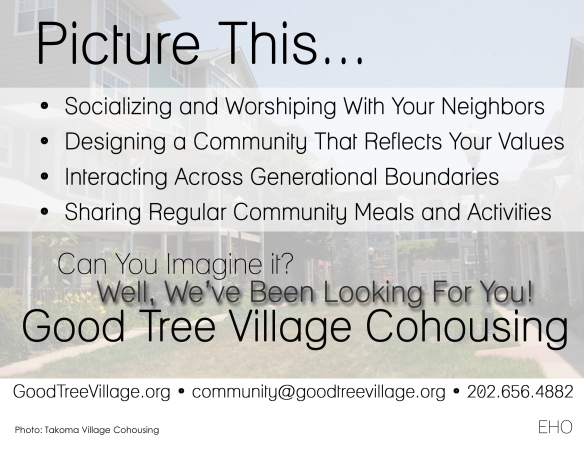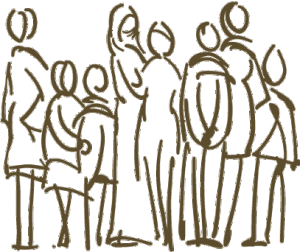
What Is Cohousing? The Elevator Speech
Rains Cohen is a Cohousing Coach who lives in Berkeley Cohousing in California. He is asked about cohousing numerous times a day, partly because he wears a pin that says, “Ask Me About Cohousing,” and partly because he is often in an elevator.
Add one line for every floor of your elevator trip, and follow the interest of the person you’re talking to — give them room to express what gets them excited (watch their response), guide them back to your core message, and build your engagement on the positive reinforcement you get, tailoring your message selection to their background/interest:
- It’s condos with community: about 20 to 30 homes on average, clustered together
- We all have our own private homes, with a large shared area — a common house
- We all have our own kitchens, but we do meals together a few times a week
- I know my neighbors, we run the community by consensus
- We’re basically recreating an old-fashioned village, overcoming the isolation of the last half century
- Some are individual homes, some townhouses, some condos [include your own project design/vision and experience here]. In general we live in smaller spaces because of our shared space and resources
- It’s a national movement, with 116 cohousing neighborhoods established over the last two decades, with a similar number under development
- We start green and get greener — way more than just the “sticks and bricks” of green building, studies show: car-sharing, composting, saving energy way more than the average American
- It’s intergenerational and very popular with parents, but we’ve got a lot of interest from boomers in senior cohousing, specifically designed to support the aging process and help them maintain their independence and stay out of nursing homes
- It’s great for activists — I can host a meeting in the Common House, without even cleaning house.
- I learn a lot from my neighbors and do things with them
- Legally it’s a condominium, so we don’t have a guru, we all have our own incomes, our own mortgages, and there’s no wife-swapping [you can apologize here if they look disappointed]
- We get professional help with decision-making and conflict prevention and resolution, so we look for mutually optimal solutions.
- It’s the fastest-growing sector of the Intentional Communities movement, because we partner with professional developers and leverage the system, so the banks will finance it and cities/counties will approve it
- It comes from Denmark, and was brought over to the U.S. by two architects [at this point if someone’s very engaged, I pull out the green-cover book]
- We’re having a meeting/orientation/tour/common meal next ___ (or every ___), [hand them your postcard-sized or tri-fold simple flyer] would you like to come learn more and see it for yourself?
If you’d like more guidance (I have an informal flowchart organizing extended talking points/common confusions&misconceptions/engagement opportunities around each of these key points), I’d be happy to provide some Cohousing Coaching around effectively delivering this message, via conference call, if your or other cohousers are interested. There also may be ways to make your website more effective at building awareness and engagement, helping build the pool of your future neighbors. Let me know!
Raines Cohen, Cohousing Coach
CohousingCoach.com
Regional Organizer, East Bay Cohousing
Author of Aging in Community, We Can do It Better Together
Source: http://www.takomavillage.org/wordpress/cohousing/what-is-cohousing-the-elevator-speech/



 Jerry lived on Doyle Street in Emeryville, CA, in the late 1980’s, when a cohousing group proposed creating a community next door. He was initially concerned about traffic, shadows, construction noise, and other impacts, so he joined neighbors in opposing the project before the Planning Commission, calling for a smaller project at a lower density with fewer units that the group members, as self-developers, could not afford. The City Council approved the project, and based on his experience with his new neighbors after it was built, he reconsidered his views on development.
Jerry lived on Doyle Street in Emeryville, CA, in the late 1980’s, when a cohousing group proposed creating a community next door. He was initially concerned about traffic, shadows, construction noise, and other impacts, so he joined neighbors in opposing the project before the Planning Commission, calling for a smaller project at a lower density with fewer units that the group members, as self-developers, could not afford. The City Council approved the project, and based on his experience with his new neighbors after it was built, he reconsidered his views on development. 
